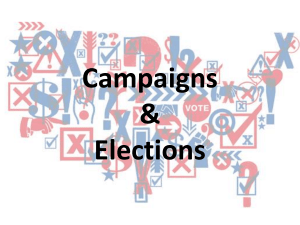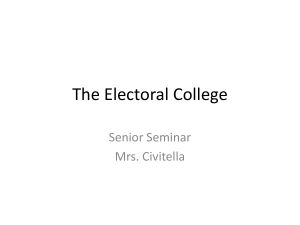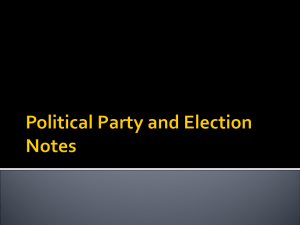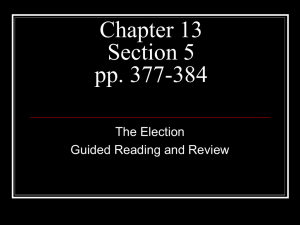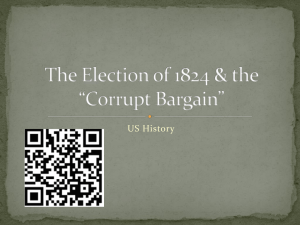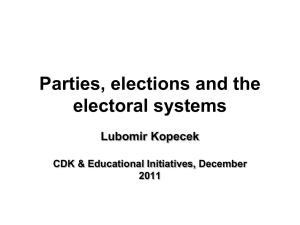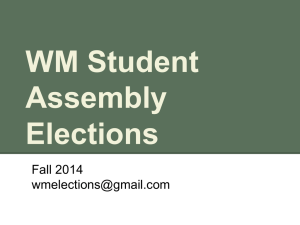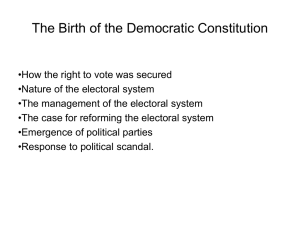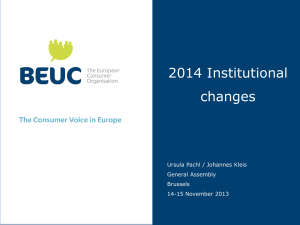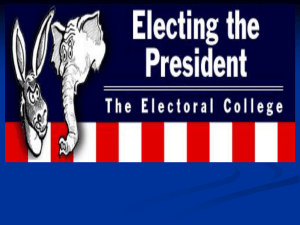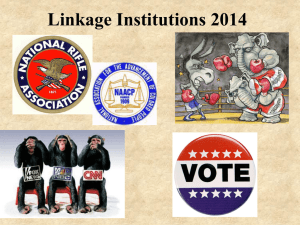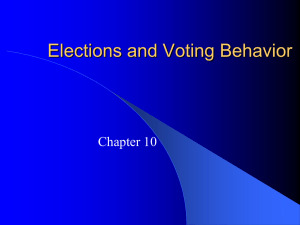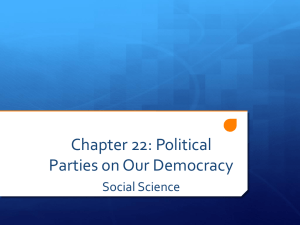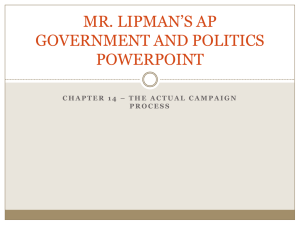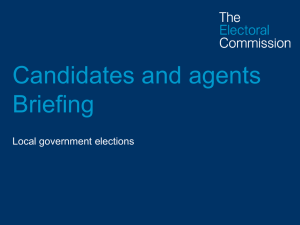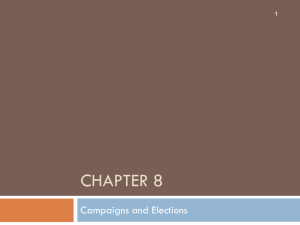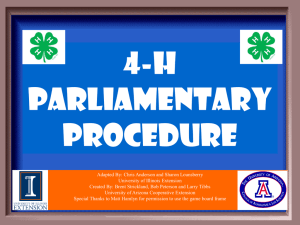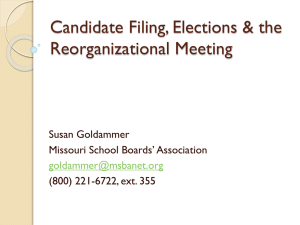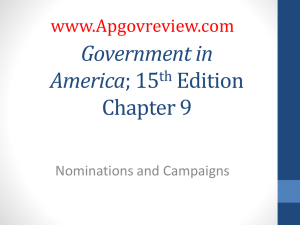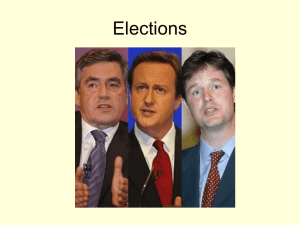Unit 5, Chapter 17 Elections and Voting
advertisement
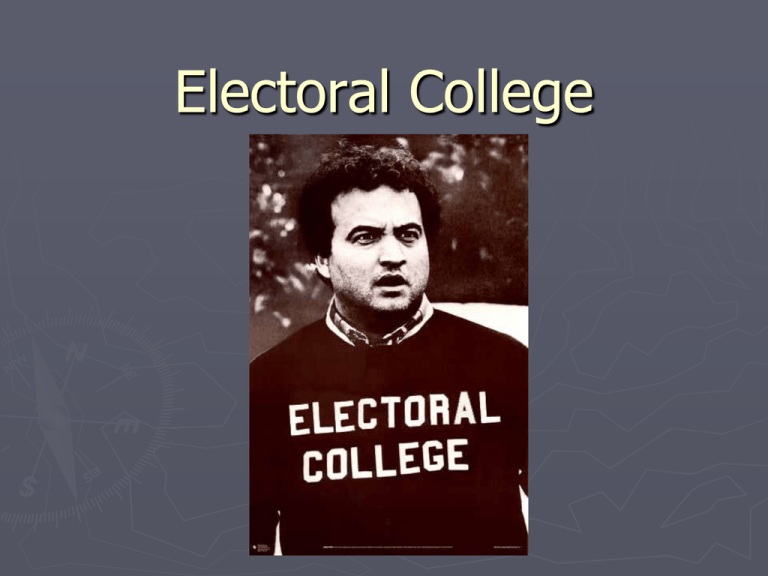
Electoral College Video ► http://www.youtube.com/watch?v=ok_VQ8I 7g6I ► http://www.youtube.com/watch?v=oTbvYG H_Hiw ► Khan Academy History of Electoral College ► In 1787, Founding Fathers wanted elite men in society to run the country. ► Were afraid that Congress would be bribed or influenced by candidates, and did not trust them, that is why Constitution puts strict limits on Congress. ► Were afraid that direct popular vote by ignorant, uneducated, uninformed masses could lead to people voting in the wrong person or could elect a dictator. Also filter passion and prejudices of the masses History cont. ► The Fathers compromised to create the Electoral College, which also helped the smaller states in allowing them to have say in a national election (Federalism). ► Also, there was only 13 states and around 4 million people, so it was difficult to count all the votes and get information and communication so an electoral college was not a bad alternative for that time. What is the Electoral College System that elects our President and VicePresident ► President is not elected by direct popular vote. (4 people have won popular vote but not presidency) ► Electors are granted from each state based on the number of House of Representative members plus Senators ► Electoral College Cont. ► D.C. also gets 3 votes (22nd amendment) ► Votes are added up on election day and the candidate receiving the most popular votes (does not have to be majority) wins all the electors from that state. Winner-take-all system (Except for Maine and Nebraska) Electoral Votes ► Candidate that wins the Presidency must win a majority 270 out of 538 possible votes. ► If not a majority, election determined by majority vote in the House, with one vote per state. Vice-President is elected in senate with each senator getting one vote. ► A candidate could win the 11 most populous states, lose the other 39, and still win enough electoral votes to win the Presidency States and Electoral College ► State legislatures select their own electors, based on their own rules, helping to guarantee them a role in the national election. ► Some states will most always vote a certain way: California, New York, Texas ► However, some states are swing/battleground states which mean that they are up for grab and any candidate could win. Most candidates will spend a majority of their time in these states trying to win their votes. Electors ► Have not other delegates have no other lawmaking powers, so they could not be bribed or influenced ► Electors meet on the First Monday after the second Wednesday in December to vote. They vote at their state capitals. Votes are then counted before a joint session of congress on January 6th. Alexander Hamilton Federalist paper #68 ► They have not made the appointment of the President to depend on any preexisting bodies of men who might be tampered with beforehand to prostitute their votes.” Arguments for/against Electoral College Arguments For 1. Electoral College contributes to political stability in the United States by encouraging only a two-party system 2. Increases the Power of the States 3. Allows a buffer from government agency choosing and from mass of public voting Arguments against 1. 2. 3. 4. 5. Hinders the numbers of parties that are able to compete in elections Take states for granted when states consistently voter for one party Winner-take-all nature of state elections renders some votes essentially meaningless Depresses voter turnout because voter turnout is irrelevant to the number of electoral votes. Rogue Electors are always possible. Changing the Electoral College 1. Proportional Representation/Parliament ary System- When the people vote for legislatures, and the party who wins the most seats in the legislature get to install a President (Prime Minister). Encourages 3rd parties but not direct popular vote. Prime Minister President may be removed at anytime by Legislature without consent of constituents. 1. Direct Popular Vote/Majority VoteMore candidates will run, making it harder to win a majority. This would mean runoff elections, more time, confusion, money, and wheeling and dealing from candidates who won for endorsements of the candidates who lost Unit 5, Chapter 17 Elections and Voting Section 1: Election Campaign Mr. Young American Government Essential Question ► What are the basis elements of a presidential campaign? ► Why and what were the purposes of the Federal Election Campaign Acts being passed? Voting and You Video ► http://www.youtube.com/watch?v=6KBo7vz rHGY Electing the President ► Most election laws are passed at the state level and happen at polling places ► President is elected every Tuesday after the first Monday, every 4 years in even numbered years in November Electoral Votes and the State ► ► ► ► To be elected President, a candidate must win 270 of the 538 available electoral votes Electoral College votes= number of Representatives plus the number of Senators Candidate who usually wins the greatest number of popular votes usually wins the presidency Emphasizes larger states, win 11 largest states and that person gets the Win Popular vote, not Presidency ► In prior elections, four U.S candidate for President won the popular vote but lost the presidency: Andrew Jackson won the popular vote but lost the election to John Quincy Adams in 1824; Samuel J. Tilden won the popular vote but lost the election to Rutherford B. Hayes in 1876; Grover Cleveland won the popular vote but lost the election to Benjamin Harrison in 1888, and Al Gore won the popular vote but lost the election to George W. Bush in 2000 Top 5 Biggest Electoral States 1. 2. 3. 4. 5. California- 55 (last 5 elections voted Dem) Texas- 38 gained 4(voted Rep 9/10 elections) New York- 29 loses 2 (voted dem in last 6 elections) Florida- 29 gain 2 (Voted Rep in ’72, 8092, ’00-04; Dem in ’76, ’96, ’08) Pennsylvania- 21 loses 1 (Voted Dem last 5 elections) Kentucky and Electoral College Kentucky has 8 electoral votes ► Since the 1950s, Kentucky has been reliably Republican, although its voters have been willing to vote Democratic when a southern governor has run – the state voted for Jimmy Carter in 1976 and for Bill Clinton in both 1992 and 1996. In 2008, John McCain defeated Barack Obama 57% to 41%. ► Campaign Strategy ► Candidates must appeal to a broad variety of voters to win as many states as possible ► Campaign managers, who is responsible for overall strategy and planning, usually lead the presidential campaign during elections Television ► TV is the most important communication tool for a presidential candidate, and also the most costly item ► Use TV to build up candidates image, metal picture to audience, and package them to the voters Internet and Campaign ► Internet is a good tool for finding information on a candidate ► Almost every candidate has a website, where you can find how they stand on issues, and where you can also contribute Money and the Election First two Presidents to really start the spedning spree was Richard Nixon and George McGovern raised $91 million dollars on the general presidential election, more than triple what had previously been spent ► 2004, presidential and congressional candidates spent total of $3.9 billion ► Congressional Money Spending ► Jon Corzine spent $65 million of his own money on a New Jersey Senate seat Congressional Spending ► Average ► Average Senate seat is $7.2 million dollars House seat is more than $1 million dollars. ► Estimated that between ½ to 2/3 of Senators are millionaires (68 in 2008) ► In 2008 average net worth of US Senators was almost $14 million ► In 2008 average net worth of Representatives was $4.6 million dollars (240 in 2008) ► Next is Top 25 Wealthiest Senators and Representatives in 2008 Money Raised for 2012 Election Barack Obama $99,597,681 Mr. Obama expanded his fundraising lead, ending September with more cash on hand than the entire Republican field. Mitt Romney $32,605,827 1st of 9 Republican Candidates* as of September 30, 2011 Mr. Romney has spent nearly twice as much as money as any other Republican challenger. Regulating Campaign Financing ► Federal Election Campaign Act (FECA) of 1971- require public disclosure of each candidate’s spending, provide federal funding for presidential elections, prohibit labor unions and business organizations from making direct contributions, and limit how much each individual and groups can contribute Federal Election Commission ► Created the Federal Election Commission (FEC)- independent agency in executive branch to administer federal election laws ► Has limited individual contributions to candidates, but unconstitutional to limit overall total cost of campaign Public Funding ► Presidential Election Campaign Fundprimary campaigns and general elections but must agree to limit their total campaign spending and private donations ► ’76-’04, all major parties accepted this, except GWB in ’00, it was $81.4 million in ‘08 ► 3rd parties may receive funding if they got 5% of pop vote in former election Private Funding ► Bulk of campaign funding comes from the private sector ► Limits direct contribution for individual at $2,500, may contribute $5,000 to PAC ► Political Action Committees (PAC)- an organization formed by interest groups to collect money and provide financial support for political candidates; direct contribution is $5,000 to the candidate and $15,000 to the national party ► PAC’s contribute more than 5 times as much money to incumbents as to their challengers 2008 Election and PAC’s ► 1. 2. 3. 4. 5. 6. 7. 8. 9. In the 2008 elections, the top 9 PACs by money spent by themselves, their affiliates and subsidiaries were as follows: IBEW PAC $3,344,650 AT&T Federal PAC $3,108,200 American Bankers Association (BANK PAC) $2,918,140 National Beer Wholesalers Association PAC $2,869,000 Dealers Election Action Committee of the National Automobile Dealers Association $2,860,000 International Association of Fire Fighters $2,734,900 International Union of Operating Engineers (IUOE) Political Education Committee $2,704,067 American Association for Justice PAC $2,700,500 Laborers International Union of North America (LIUNA) PAC $2,555,350 Private Funding cont. ► Issue advocacy advertising- urges voters to support a particular issue, such as gun control or health care ► Will often contain candidate’s name or image, but will not say vote for or against a candidate McCain-Feingold Bill ► Bipartisan Campaign Reform Act (BCRA)targeted the use issue advocacy ads and softmoney donations to national political parties ► Soft money- donations given directly to political parties by PAC or individuals for general purposes, such as voter registration drives, party mailings, and political advertisements BCRA cont. ► Banned all soft-money donations to political parties, but raised individual contributions ► Prohibited unions, corporations, and nonprofit groups from running ads aimed at candidates within 30 days of primary election and 60 days of general Citizens United vs. Federal Election Commision (2010) Overturned BCRA by saying that it was a violation of Freedom of speech for placing limits on independent spending for political purposes by corporations and unions. ► Also allowed corporations to show ads mentioning a candidate within 60 days of general and 30 days of primary. ► Campaign Law and Internet ► Web site operators must identify themselves online, even if they are acting as individual citizens ► Web sites operating independently of official campaigns must register with FEC if they spend $250 or more on the site
